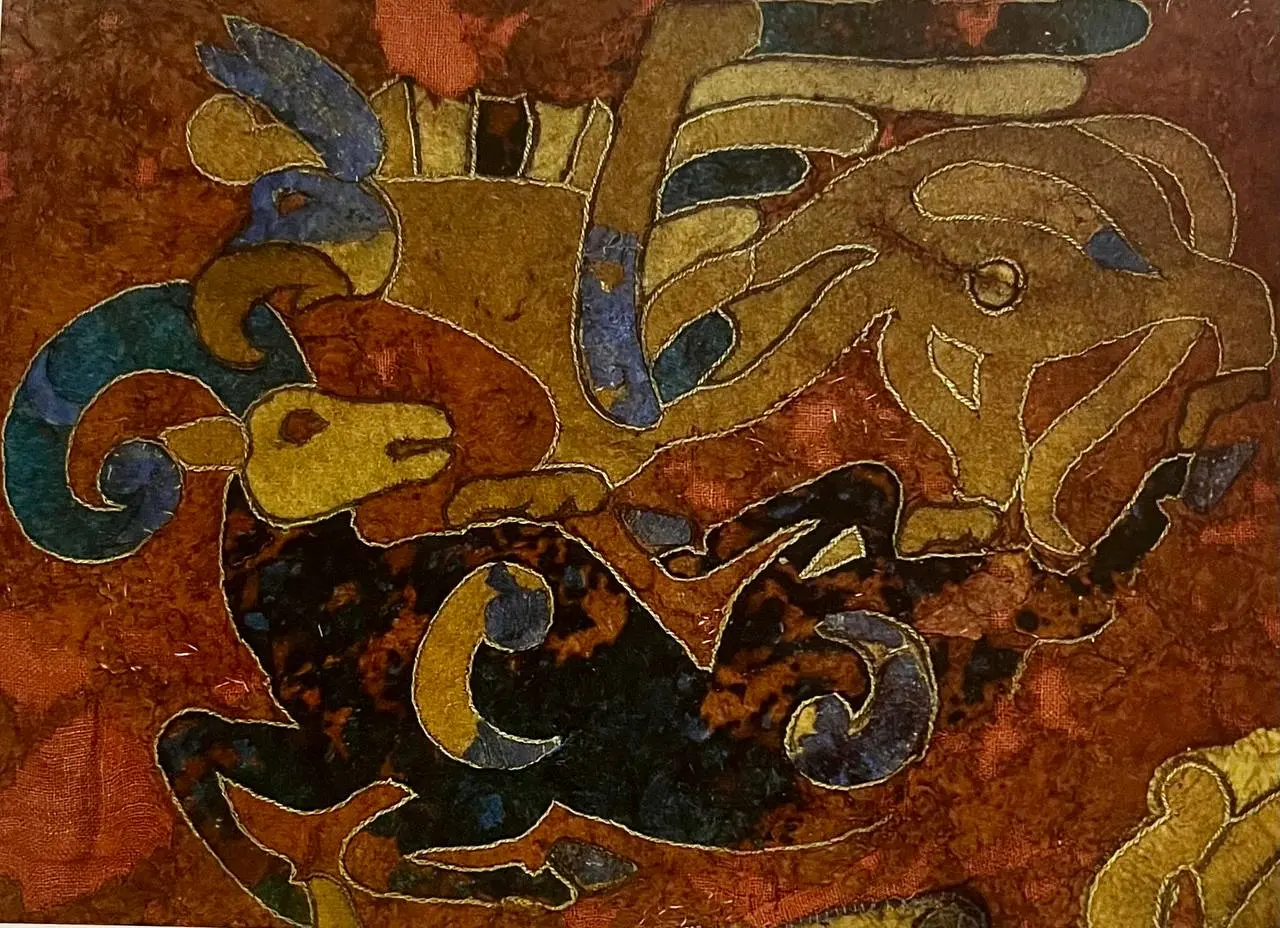The first archaeological evidence of knotted rugs
One of the oldest documents of knotted carpets has been obtained from an archaeological place in northwestern China: The first archaeological evidence of knotted rugs The first archaeological evidence of knotted rugs In 1960, a team of archaeologists began digging in Qinghai which is situated along Normhong River the ends to Tsiadam Lake. This village is one of the many villages that are located between Lanzhou and Qinghai that represents the culture of Majiayoo, a culture that was developed in Neolithic period and was superior to the last culture of residents (Bampo) and one of its features was its considerable skill in producing handicrafts.
Ceramics produced in Majiayoo were the finest one in china in Neolithic period. And exceptionally woven parts from wool have been found in the district in banks of Normhong River. Among them, a primary pile woven of two colors red and blue is seen which is kept in the museum of Qinghai and archaeologists believe that belongs to forth millennium BC. It’s a matchless finding and it’s noteworthy that this finding reveals that weaving was totally clear and well-known in that area because some parts of hemp have been found in there, too.

These small parts discovered in Normhong are the history of knotted carpet and it’s not the only proof of spreading this technique among cultures of Neolithic period and Bronze Age in Central Asia.
In one of tombs of Tribrata, a place in the lower alluvial plain of the River Volga, there is a grave of a blue-blooded related to third millennium BC was dis-covered. Beside the rooms of the grave, there was remaining of image of a wagon on a carpet that just the trace of wheels and the shape of diamond have been remained.
In some toms if women of that era discovered in Sum-ber valley in Turkmenistan, Iran, curved blades made of bronze have been obtained that archaeologists guess that they had been used as an instrument to weave car-pet. Similar instruments have been found in Hissar hill and Shah hill related to the very era.
Also it seems that it was frequent to weave handmade woven: Weavers made piley woven using ring weaving technique on a tissue which was just warp and woof of linen, and used it as a cover for bed or floor.
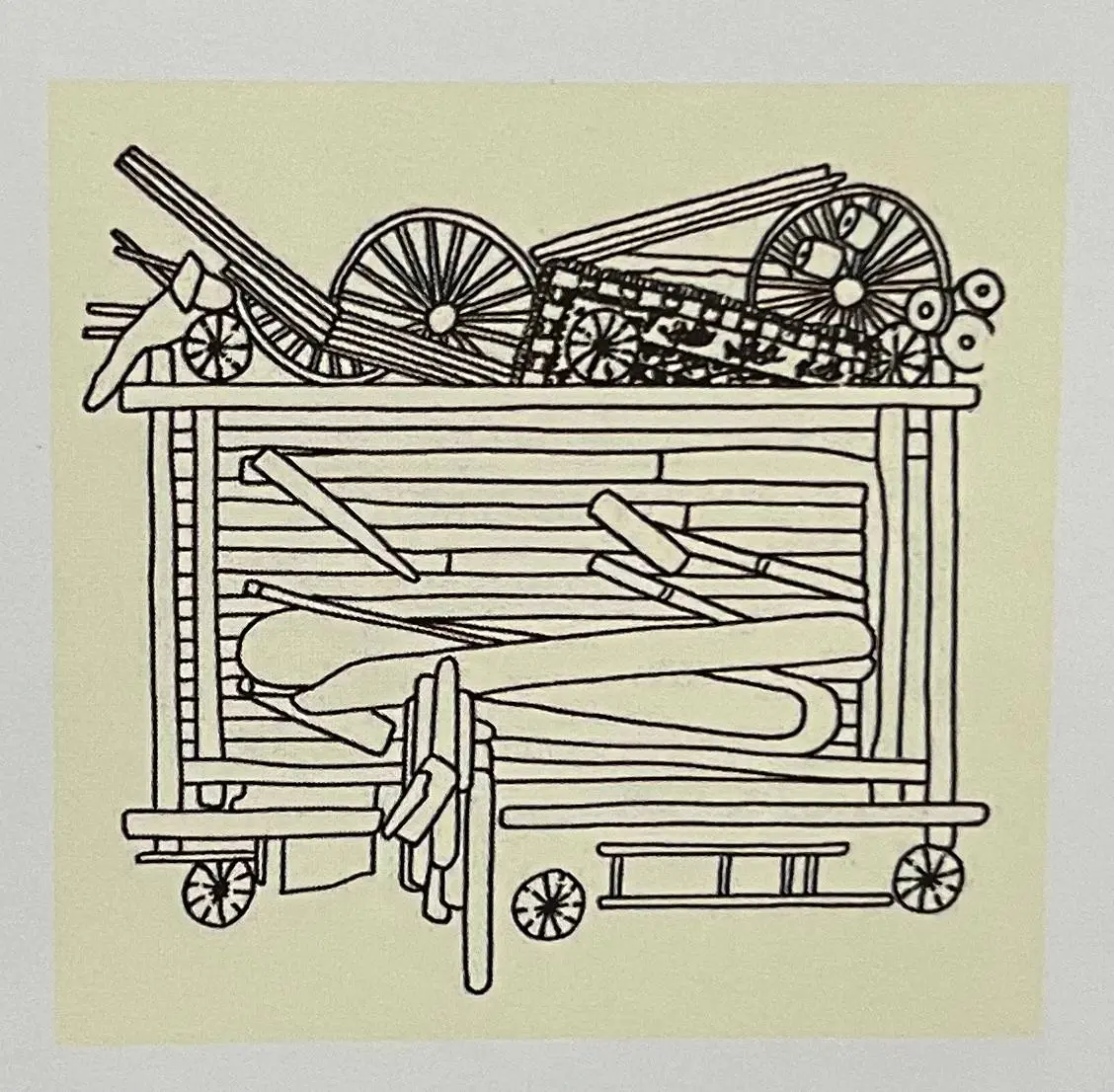
We can mention woven discovered form one of a great architectures of eighteenth dynasty of Pharaohs – Kha – and his wife – Merit – which have been found by Schiapparelli – an Italian archaeologist – is keeping in Egypt museum of Torino, or bed sheet linen piley
“Deir al-Madina”, from about 1450 BC which is kept in Louvre Museum as samples.
Herodotus describes the properties of the woven as fol-lows: While the others comb wefts from bottom to top, ancient Egyptians had done it from top to bottom by combs from metal.
They also soaked wool in the water to be span better and consequently have a finer thread.
Egyptians rarely used wool because they knew it dirty.
Based on Herodotus, they put woolen shawls on their clothes, but they never entered to the tombs by these shawls and avoid using woolen goods in burials, too.
Herodotus and Pilinio both believed that Monks’ cloths were made of cotton, which was called Gossipium and linen or Linum Usatissimum, were other fibers used in that.
They employed Isatis and Indigofera Tinctoria for dark blue and Lawsonia Alba, Robbia Tinctoria and Coccus Ilisis for red.
Murex shell, which has been used for purple, was unknown at that era.
Cartamo that is a kind of mignonette, scientifically called Reseda Luteola, and Crocus Sativus were used fir yellow.
Totally tangible proofs of using piley rug similar to current rugs back to the latter half of first millennium.
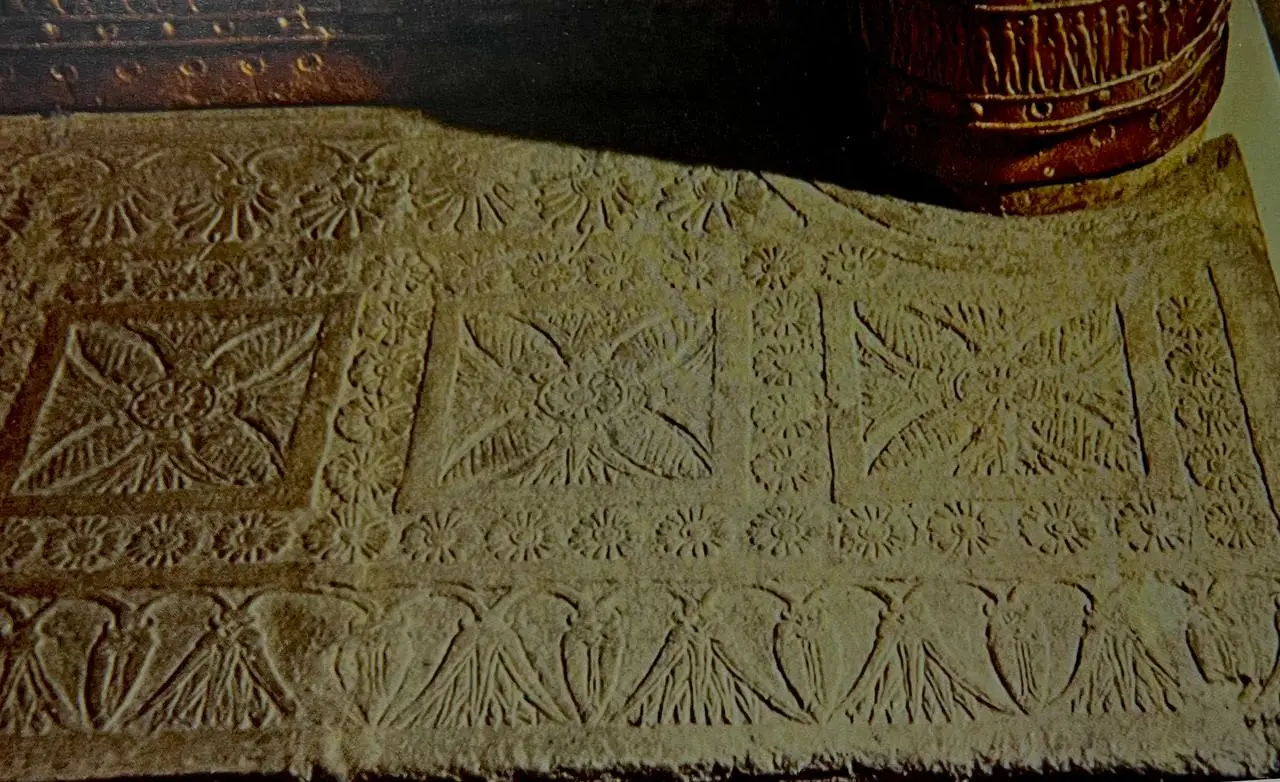
The first knotted carpets
The most famous one is Pazyryk, which is a precious car-pet in Armitage museum of St. Petersburg. Scholars, researchers and collectors’ interest to the evidence of ancient tribes led to discover Pazyryk.
These ancient tribes, based on Herodotus, were called
“Shit” by Greeks and “SAKA” or “Scythians” by Iranians had nomadic lives around Caspian Sea. Pazyryk Valley, along the high Altai is located approximately twenty kilometers from the Chinese border and has peerless historical monuments, was discovered in the late second decate of twentieth century and immediately it was recognized that it has highly specific environmental conditions that has contributed to the maintenance of a lot of objects. In fact this condition brought an absolute cold deep in the ground, i.e. a permanent freezing. Hardness and compressibility of soil and low temperatures retained objects that could be destroyed by the passage of time. Gurkans were burial chambers of Scythians, acted as refrigerators and by keeping valuable objects brought us a lot of precious information to recover Scythians’s lifestyle.
These ancient tribes were categorically different from each other in origin and accent, and have firmed commercial ties and cultural relationships with near tribes or far away one line Chinese. Pazyryk valley was used as a cemetery about 400 years before Christ.
Radio carbon dating of woods of the cemetery has determined that five Gorkans were built in the period of eight years. Noticeable part of the Gurkan is the final part of the valley that resembles a small plateau.
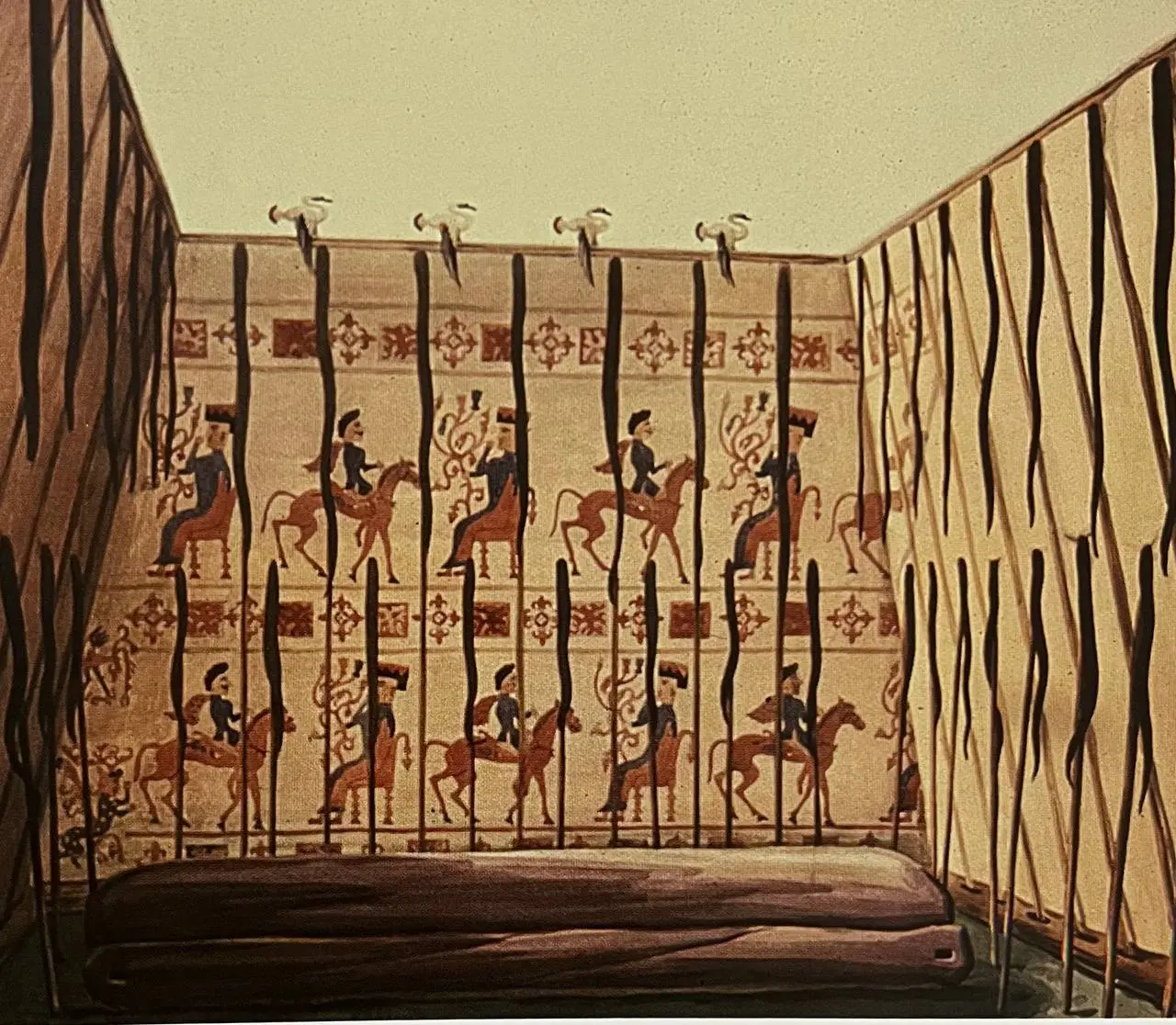
Eight burial chambers based on the traditions of Scythianss have been built at that place and near each other: burial chambers had been built on the ground floor to a depth of about three meters, with an area of 20 to 50 square meters surrounded by the trunk of trees surrounded by, and smaller holes in the side that was used to bury horses. Inside the chamber was covered by felt and body was put in a coffin made of the tree trunk Larys covered by pictures of animals. The ceil is wooden that is placed on a layer of stone and wood to create impenetrable grave in front of dirt and they put gravel on that to create a hill with a height of about two meters. Employing thick layers of soil and rock that was used as a coating on the grave, absolute old in the burial chambers was maintained. In Pazyryk, moisture and condensation phenomena had brought absolute cold into the chamber and rainwater seeps through the underground tunnels dug by the robbers created thick layers of transparent ice. These tunnels of ice kept many objects from the destruction over the time or thievery. Leather sacks and bags, felt, cloth from fibers of wool and animals hair were found that leather or layers of gold with wood and handicrafts were employed in them by the patient discovering actions of archeologists.
The first archaeological evidence of knotted rugs persian rug fhciran
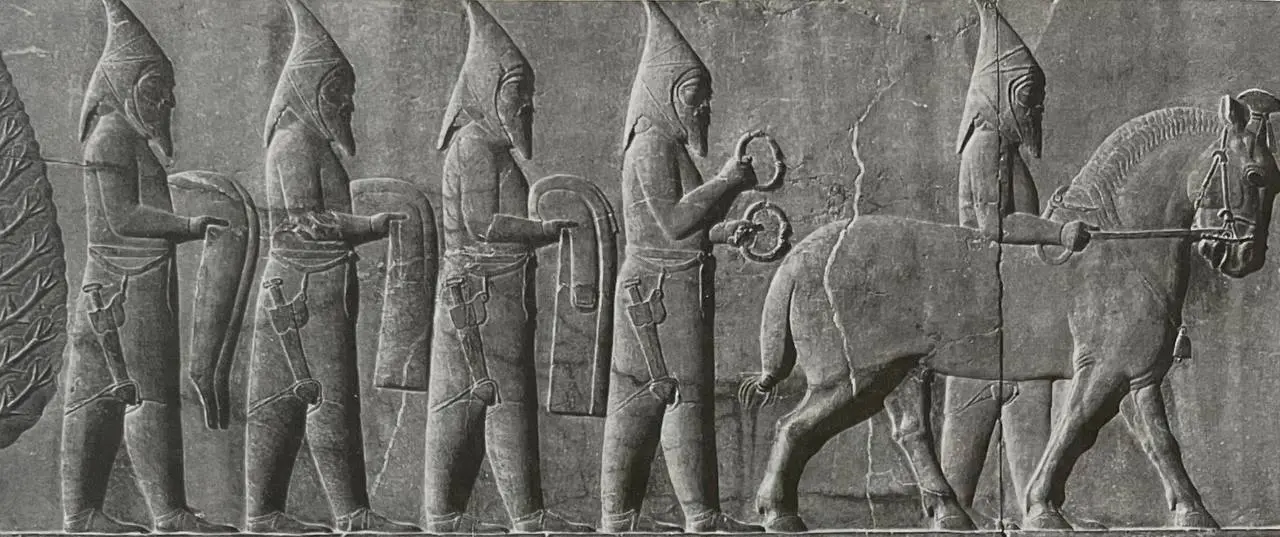
In 1865, Radolf, Berel and Katanda posed the hypothesis of exiting Kurkans of Scythians in Pazyryk. In the beginning of 1929, Sergei Ivanovic RudenKu and Gri-azniv launched these diggings and in 1947 finished by the assistance of Russian Science Academy and Armit-age Museum.
In the burial chamber, remained parts of some horses and a wagon were found, but a team under the command of Rudenko more importantly and wonderfully found a large carpet from fifth Gurkan which has been amazingly kept. In carpet has been kept in Armitage museum in St. Petersburg. It’s rectangülar in 189X198 cm, dimensions proper for covering the floor of a hearse wagon, totally wove with wool with compressed wraps and loose wefts. There is a nod after 3 or 4 wefts in each course, so there are 3600 nods in each dm2 that are almost regular and systematic.
There are 2 mm long fringes in both ends of the car-pet. Wool is dyed naturally. Indigofera Tinctoria and red inspect have been detected. Of course colors have been changed over the time, they are pale and they are toward bright pink and green while they should have been clear and vivid. This finding enjoys a complicated design and a crucial proof to prove advanced artistic capabilities of that epoch.
Background leads to two long strips like a frame and Shows various images in a row, rectangular with a mythical animal, Griffin, that has a powerful body, wings and head like an eagle and horse riders in a sin-Ble file from outside to inside, some objects like stars are seen and a row of deer with spotted skin and antlers browsing with bended heads, rectangular with Crit-are seen in the last row.
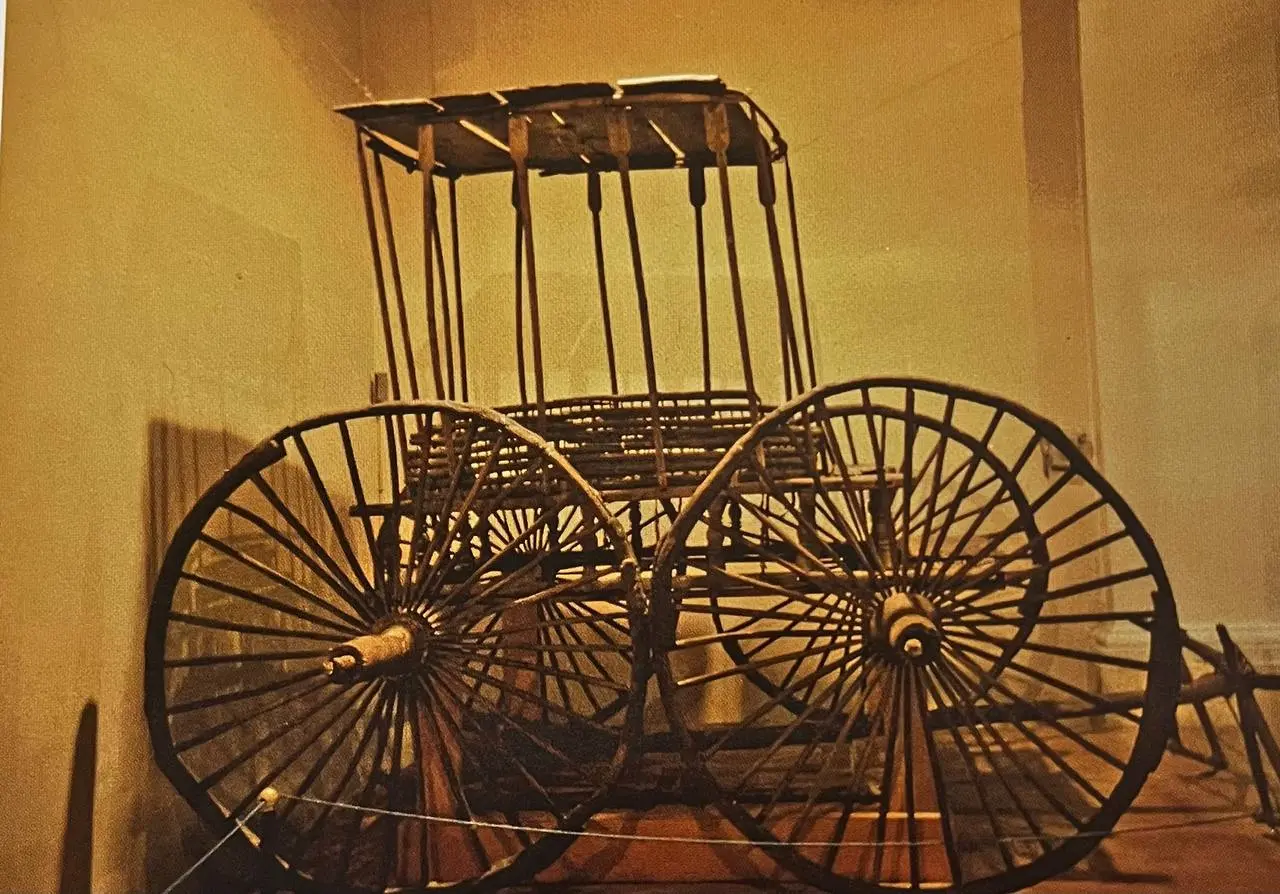
Inside the background is divid-co into four regular rectangular, six rows consist of four homes having a fioral design consists of four Mirabins like a fan that are attaced to ohe stem are seen andalso four cone-shaped decorative designs that are placed in diameters.
By studying the stone doorways of Assyrians palaces attained by the excavations of Nineveh that they belong to the sixth or the seventh century BC, we can conclude that the designs in the rock resembles the design used in the Pazyryk carpet.
Deer and the mythical Griffin, were used a lot in the traditional paintings of Scythians, particularly in paintings that were associated with burials, like illustrations that are found on graves in Pazyryk, but there is a difference between slow and fine motion of deer on the Pazyryk carpet and the style which was employed in painting the images of animals in the art of Scythians. In the view of horse riders parade, some of them are sitting in the saddle and some other are standing beside their horses while wearing stretch cloths and helmet up to their throat and put it like a shawl without any similarity with head covering in the culture of Scythians. Horses are short, stout with short mane and nodded tails. There is a cover on the back of horses with fibrous edges that have a hook-shaped design. Generally it seems that these images indicate the role of carpet in traditional burial. Noticeable point is the number of horses and horse riders are 28 and this number is exactly corresponded with the number of Achaemenid satraps.
Deer and mythical animal, Griffin, were animals related to burial ceremony and traditional parade of horse riders has been carefully explained by Herodo-tus: in the first anniversary of death of a prince, his close relatives gathered in the end of the ceremony in a single file. Men and horses surrounded the grave to support permanently their leader who rests in peace in there. There is a firm relationship between the carpet and Iranian and Assyrian art.
The relationship with Iranian art is crystal clear: The decoration of background is similar to the ports of Assyrian palace and the border scheme resembles the glory of Persepolis embossed images.
The first archaeological evidence of iran rug
Also space divisions with long illused with images on the Crground with geometric distribution are corresponded with images on the findings of Achaemenid era. Although the origin of this carpet is controversial, it has related the images and traditions of both cultures that they shouldn’t be considered categorically separated even by having differences in the fifth century before Christ.
Pazyryk carpet can’t be considered the only proof of ancient art of textile, in Basadar, 200 kilometers away from Pazyryk, Rudenko found another carpet with the density of 4900 nodes/dm2. In addition, in the books of classic epoch, we can find a lot of texts indicating lots of carpet, which were used to decorate homes and palaces. And sometimes the origin of the very carpets is explicitly mentioned: for instance, Gezenfun talks about oriental carpets, while Tolomeo Filadelfio describes Iranian carpets with short pile and contained animals’ im-
ages.
A Japanese archeologist team supervised by Professor Fujii Hiedo from Kokush-ikan University launched a series of excavation in the caves of Tar-Al in 1971-
1977. These caves are located in southwest of Iraq and 55 kilometers away from Karbala and Salt Lake. There are four hills with deep caves that were dug in second millennium BC with military purposes.
In fact these caves were dominant on the crucial commercial routs that passed various towns to connect Mesopotamia to Arabia. For an easier defense, there were deep moat in the caves, and among four hundred moats, stone filled some of them, sandy sediments that were brought by dessert winds covered some.
Primary usage of aforementioned caves in third millennium BC was to be used as chamber tomb. Archeologists found tombs belong to Parthia era (about 247
BC to 226 after Christ) or Sassanid epoch (about 226-651 BC).
About four thousand textile items were found that radiocarbon them dates back to between third century before Christ and fourth century after Christ.
Most discovered textiles were cloths or shroud and after some tests in laborato-ries, it was clear that had been wove from different fibers of cotton, linen, hemp and especially wool. They were handmade and were knotted by a conspicuous elegance and span with diameter around 0.2 mm.
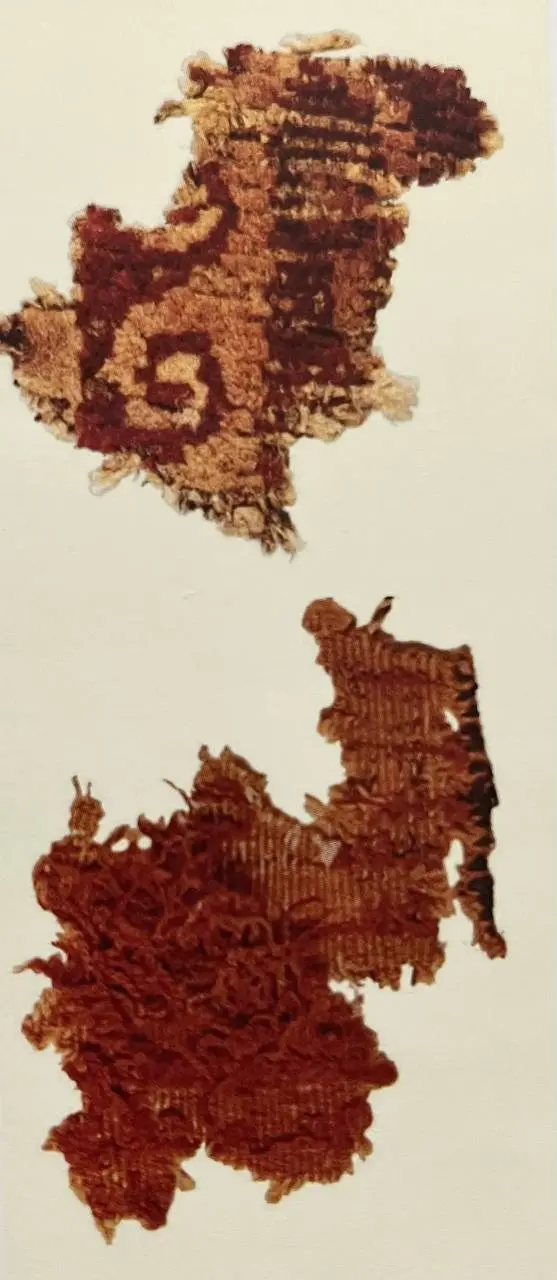
and sometimes different fibers were used as warp and woof. Dying stages were before spinning for cotton and after spinning for wool.
Sometimes desired color achieved by winding two strands of fibers with different colors, Madder, Neil (Azure), cochineal insects and shellfish purple Tiro were recognizable among used dying materials. Most found items from Tar-al were simple flat textiles wove by various textile techniques and were decorated by colorful illustration designs. It seems that most of them had been wove by balanced technique that warps and wefts were completely visible. But some other have such compressed wefts on each other that consequently no warp is visible. By changing the color of wefts, sometimes curvy, a special design has been attained that in some cases it’s possible to enhance clarity by inserting extra wefts from sides.
The most elegance is seen in small decorative items which had been used in cloths and shrouds: most of them are portraits that are based on Greek-Roman art due to the style of hair, appearance and the way of looking. In borders, designs had been used that became frequent later in carpet like medallion.
About ten found items from Tar-al were knotted. These findings were the oldest parts of carpet with origin of Iran and it’s noticeable that mostly they had been used as shroud. These hand wove items were wove just with woolen threads. Two intertwined threads were used as warp and one simple thread as woof. Most of these items were double-faced and they had short pile with high density in one face and distance of the knots was less in other face. The reason of this technique was to make more friction in one side to prevent motion and sliding. So it brought the hypothesis that probably these items had been used on saddle or similar cases.
There are various knotting styles and five of them have been known.
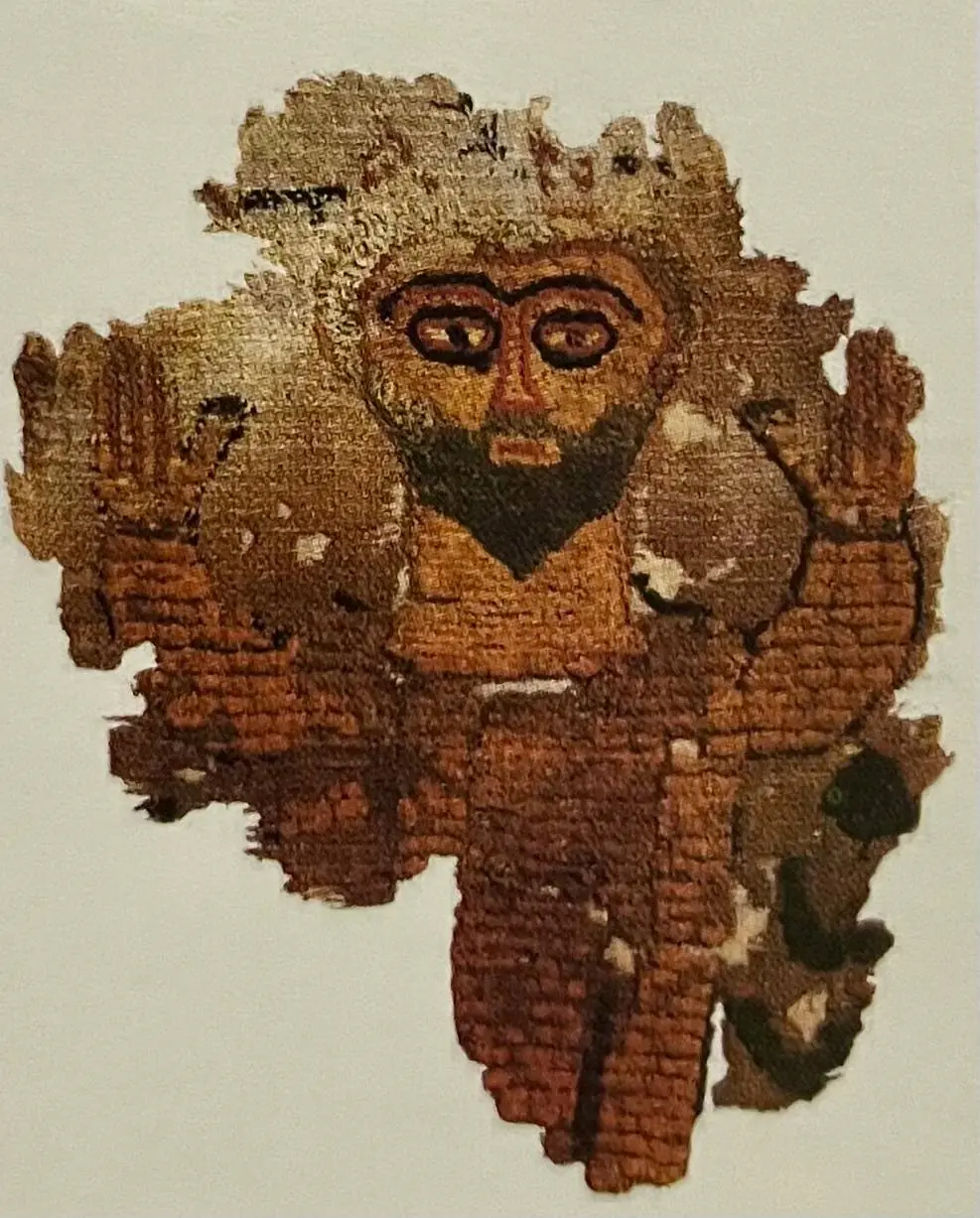
The most frequent one, is symmetrical that is wound around two warps and it has another type that it’s wove in a way that two side of carpet are piley. Second style of knotting is called asymmetrical which is similar to what is used in Iran nowadays.
There is another type of asymmetrical knot that make a few pile. In third type, knot is made just on one warp; there is no sample of this type with the origin of other parts of the world, so it’s assumed that the origin of that is Mesopotamia: one strong woolen thread consisted of seven or eight threads is wound around one bunch of three warps and is cut. Sometimes this bunch is done on both faces of the carpet: a lot of wefts are passed among each course (between three and six) that should be firmly compressed.
Finding these items that are kept due to special cli-mate, confirms continues development of the art of carpet among old oriental tribes. There are a lot of instances in this regard.
A piley linen part was found in an old tomb in Tebe belong to year 280 after Christ which had been used as shroud. A lot of parts have been found in Fayyum belong to fifth and sixth century after Christ. A small wove part by wool and with a structure line today’s knotted carpets has been found from Antinoe belong to fifth century. Also similar with pile of wool or linen and simple decorative designs parts have been found with origin of Palmira and Doura-Europos.
The latest information about this field is related to the first century after Christ and form excavations of archeologists in the beginning of this century in East Turk-menistan. East Turkmenistan is a vast country located in the east of China and Tian Shan mountain range divides it into two parts.
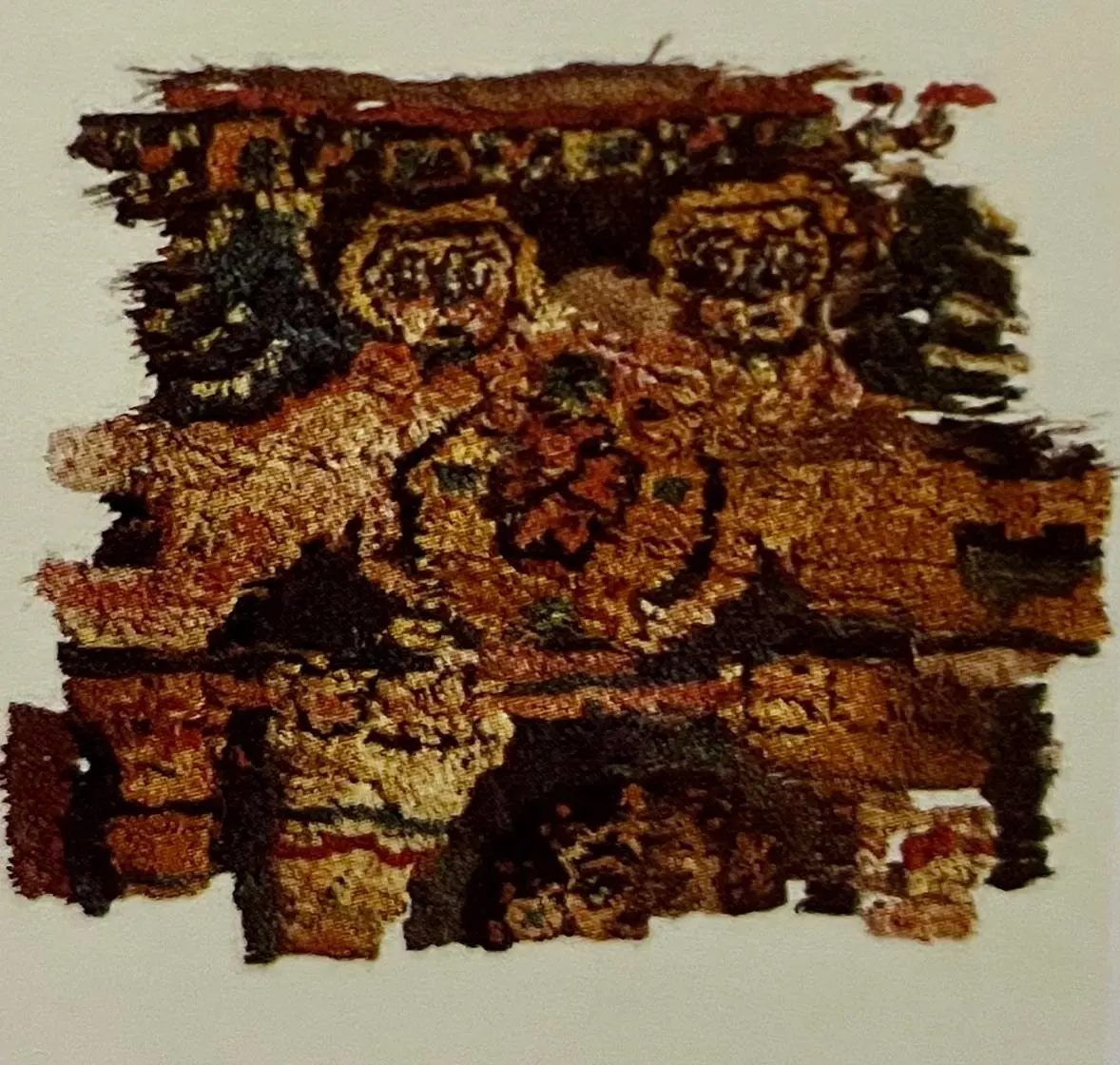
Tarim River passes through it and goes into the lake Lop Nor. Kashgar, Yarkand and Zungary are popular cities. This area that forms Xinjiang State of China is as big as Iran and known as Kashgar and Hotan among Muslims. This area is historically critical because old Silk Road had been gone through where had been passed left and right side of Tarim River. The water of this river goes into Lop Nor Lake after disappearing among the sands of Taklama-kan dessert area and there are remains of residential places on the banks that probably were towns years ago. Indigenous residents were Indo-European and were substituted by settled Turkish tribes.
There is rarely changing in climate of East Turkmenistan or Xinjiang and it’s almost always dry. This lack of humidity makes keeping a lot of objects in historical places and cemeteries feasible. A lot of textiles and more or less carpets in pieces have been discovered.
The first ancient findings in this area back to the beginning of twentieth century. In 1901, Sir Marc Aurel Stein endeavored expanded excavations till 1913.
Stein focused on research in Lou-Lan, where was a military area in north of Lop Nor and became abounded between third and fourth century after Christ probably due to shifting the path of Tarim River. Among the first excavations in this area, two hand-wove items were found that are called “Woolen Knotted Piley Carpets” keeping in Victoria and Albert Museum of London. Similar items were found in next excavations in Niya and Tunhuang.
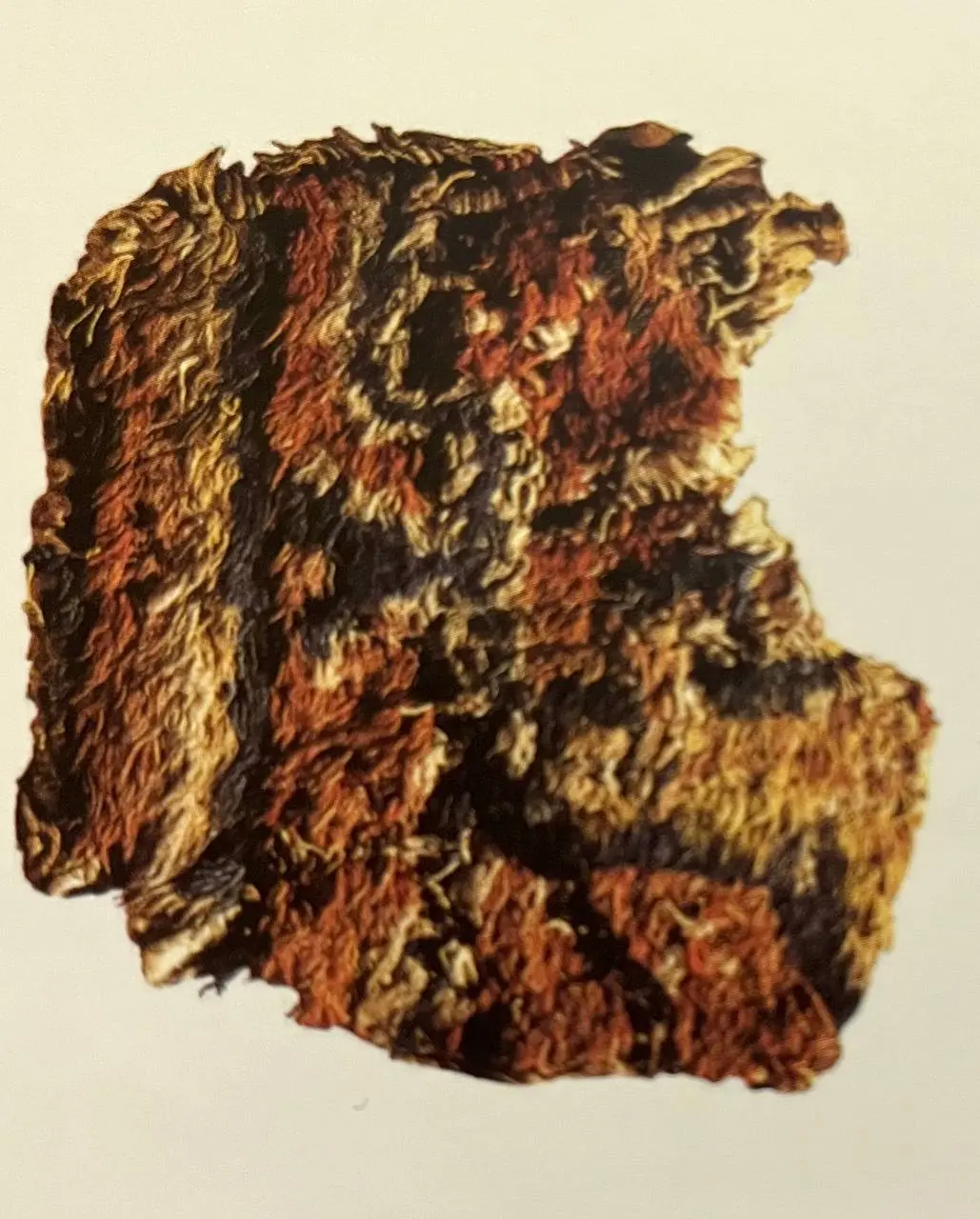
Also wove items by silk were found which were colorful and shinny with fine dec-orations. Most of aforementioned findings are keeping in Museum of New Delhi. Results of these findings and research of Stein have been published in Ruins of the Desert Cathat and in Serindia and Innemost. A lot of knotted hand-wove items are among the discovered items due to the help of pure dryness of the climate.
They are mostly woolen and various knots are visible in them: form symmetrical or Turkish to infinite knots on just one warp.
Stein mentioned in his papers that these findings are similar to the ones found in Tar-al. having reGülar knots in back to enhance friction is a tradition which is observable among his findings, too. It’s hard to detect the used design in findings but anyhow it can be said that it’s geometrical and sometimes netted. Stein estimated that the findings of Lou-Lan and Niya back to third or fourth centuries after Christ. In 1913 a similar items by knots on just one warp found in the northern part of Tarim in Kizil by Albert Von Le Coq, a German Archeologist.
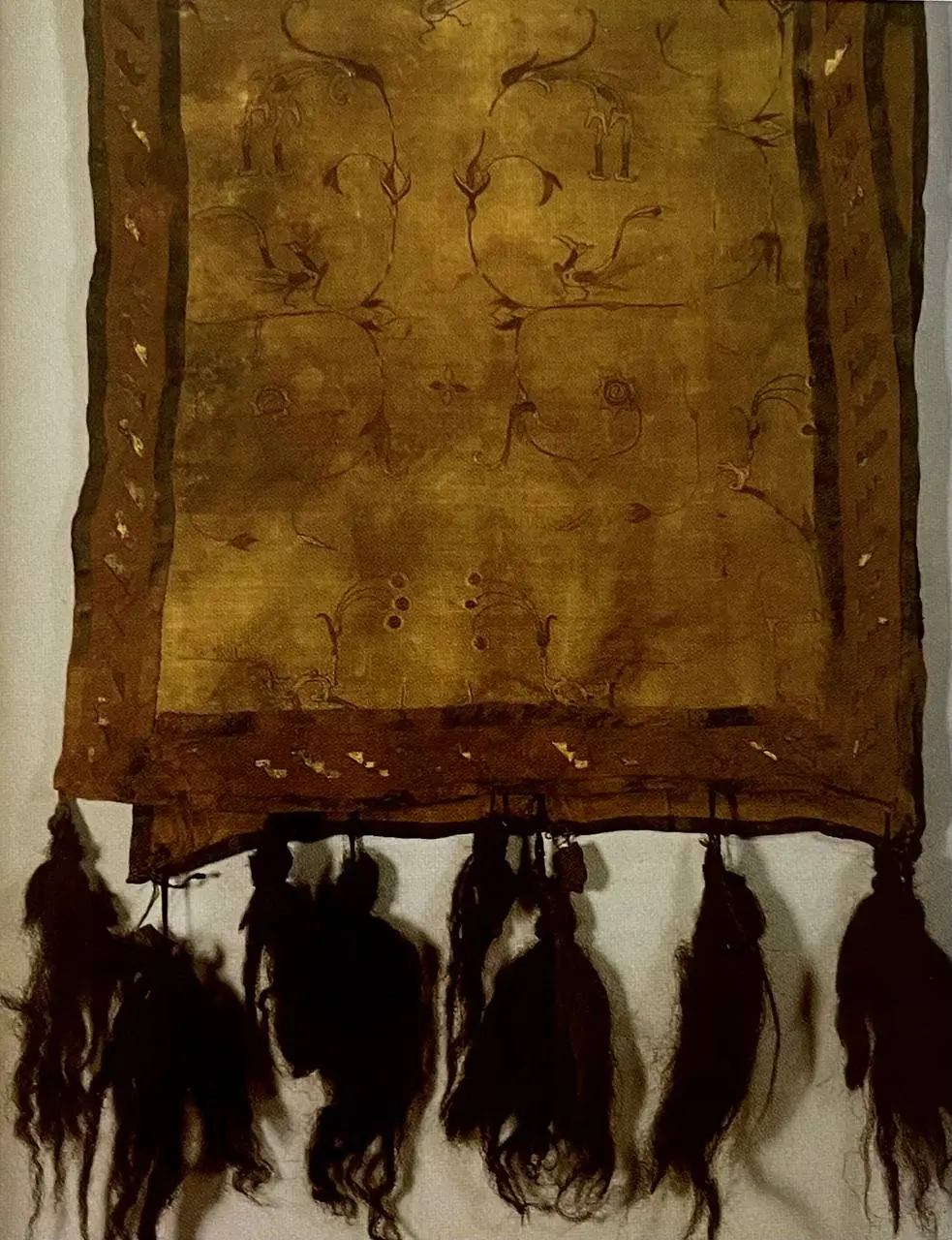
The first carpet in the world is absolute to Iran. The archeology of rugs
Some researchers believe that it belongs to fifth-sixth centuries after Christ. Unfortunately just a small part of its complicated design has been kept with winding golden image and black is seen sectional in that and in the end, a red trace is seen. Knots, which are just on one warp make pure woolen pile, like what is seen in Stein’s findings. Sven Hedin in banks of Lop Nor discovered more textile items. He was a Swedish archeologist who found wove woolen and silk items with eight parts of knotted carpet in 1934 and Vivi Sylwan, one of pioneer researchers of oriental textile, published them in 1949. These items had been wove symmetrically by a woolen structure and reGülar borders in small dimensions that prevent the opportunity of posing hypothesis about this design and just it can be said that it has been enriched by employing various colors. Variety of weaving techniques used in items found in the bank of Tarim River gave the chance to pose the hypothesis that these items were not wove by natives and were originated from different parts of oriental world.
Similarity of the knotting techniques used in items of Tar-al and later in Al-fostat (old Egypt) led to the conclusion that weaving techniques were by far more than what we have today in first centuries after Christ and despite little available evidence, the use of carpet had been frequent.
In the second half of twentieth century, between years of eighty and ninety, new items of knotted carpets have been found by Chinese archeologists in East Turkmenistan and Xinjiang in the excavations done in cemeteries of Han and Jin era (206 BC – 316 AC) or around bank of Tarim River near Northern and Southern Mountain Ranges (420 – 589 AC). Some of these items were totally intact and their colors haven’t been changed at all.
It’s worth mentioning that a rectanGülar carpet that may be used as a cover for saddle was found in a cemetery of Shanpula in Hotan in a chamber of Han era among well-kept items.
By Radiocarbon the age of wool estimated to the period between 229 AC to 276 BC.

Aforementioned carpet is small and was used as a cover of saddle. It’s rectanGülar with a background consisted of joint diamonds that there was a simple flower in each one: the other floral images were in a single file in the red background of border. But in addition to this, and in addition to many parts that have been found, archaeologists have found two carpets almost complete. The first one was discovered from a tomb in Niya Minfeng cemetery in 1995. This tomb had a wooden coffin with two bodies, a man and a woman, that researchers guessed they could have been a royal couple, King Jingjue and his wife.
A big carpet was wound firmly around King’s body as a shroud: the carpet length was above 238 cm and it should have been wider than 118 cm but some of that have been ruined over the time. The carpet had warp and woof with irreGülar colors and a lot of pile with height of 1.5 cm.
Knots of this carpet were symmetrical. There were six to ten wefts between each two courses and in each dm2 11 knots in length and 31 knots in width could be seen.
So the carpet enjoyed a high density in regards with knots and about the used decoration, it can be said that although central part has been ruined and decomposed over the time, it can be imagined completely.
The very carpet renders a geometrical image like the models that were frequent among findings of Xinjiang.
In fact among findings with acceptable dimensions, mostly netted decorations are detectable that four diamonds with a space full of triangles, small diamonds, flowers and loaves. And decorative style is so precise and eniovs specific reGülarity.
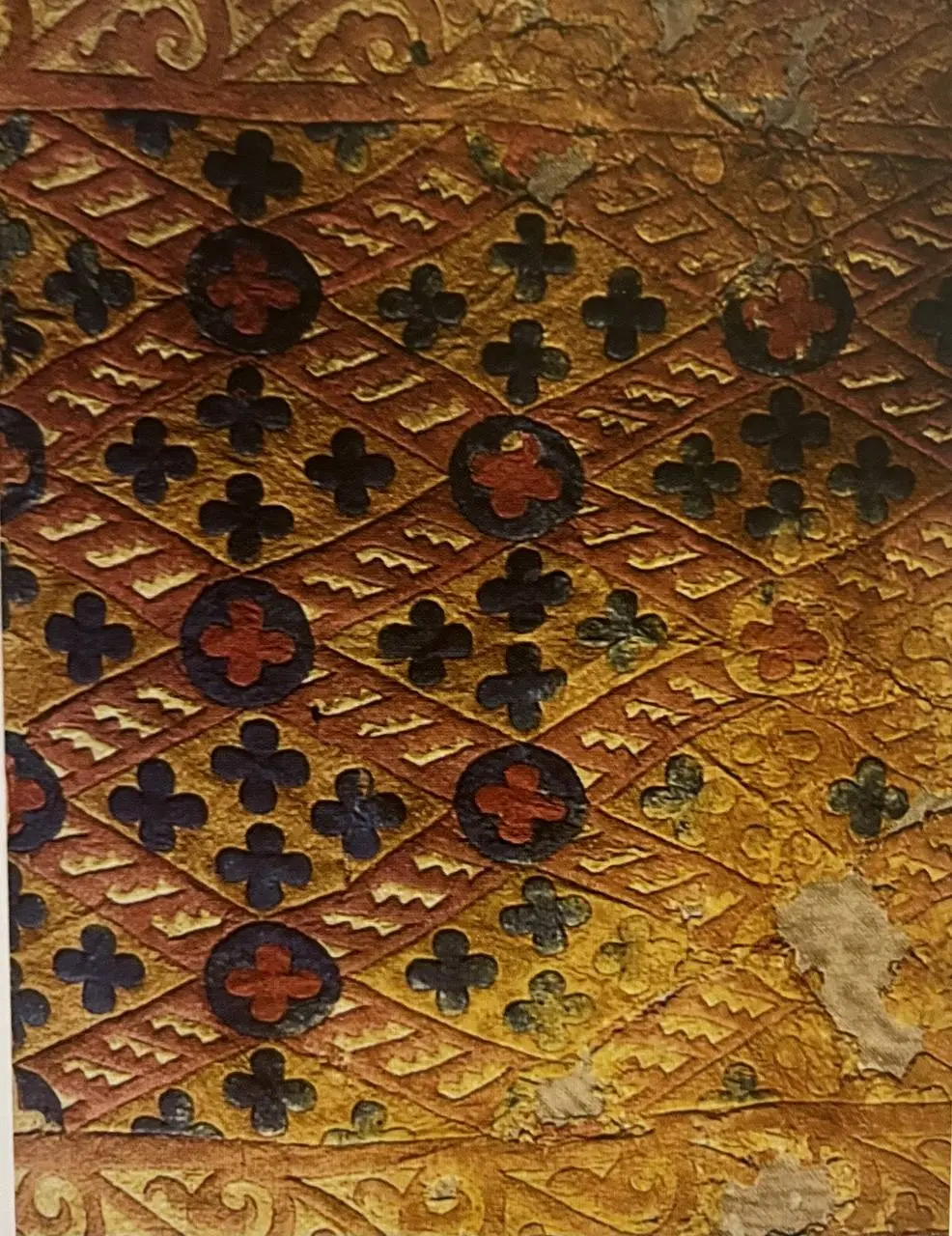
Decorative objects used in carpets are like the other textiles like broidery or woolen wove items or even other handmade objects. For example, what is seen in Affreschi in wall paintings of Buddhist caves can be seen in architectural decoration and woodcarvings.
If we mean to investigate in details, Niya carpet enjoys a vast border and four concentric frames woven with darker colors are also seen. From the outside, the rec-tanGülar frames in blue, green, red, white and brown are visible that have lost their color over the time.
There is another frame with wavy lines in colors of yellow and dark brown, and two wider frames with two different designs: The first one is consisted of squares, hexagons of colors such as dark red, pink and yellow and the other consisted of a set of triangles in two shades of green and pink. The background of the carpet contains long images of light blue diamonds on dark red background and there are flowers with six petals in yellow, green, blue or pink in each diamond.
Another wonderful carpet was discovered in the tomb of a prince in Yingpan, Xinjiang in 1995 and is keeping in the Institute of Archeology of Urumchi. Yingpan cemetery lies near the bank of an old river in eastern south of Lop Nor about 200 kilometers away from Lou-Lan, which is a rich place in regards with archeology.
There are some ruins beside it that no discovery has been done in there yet.
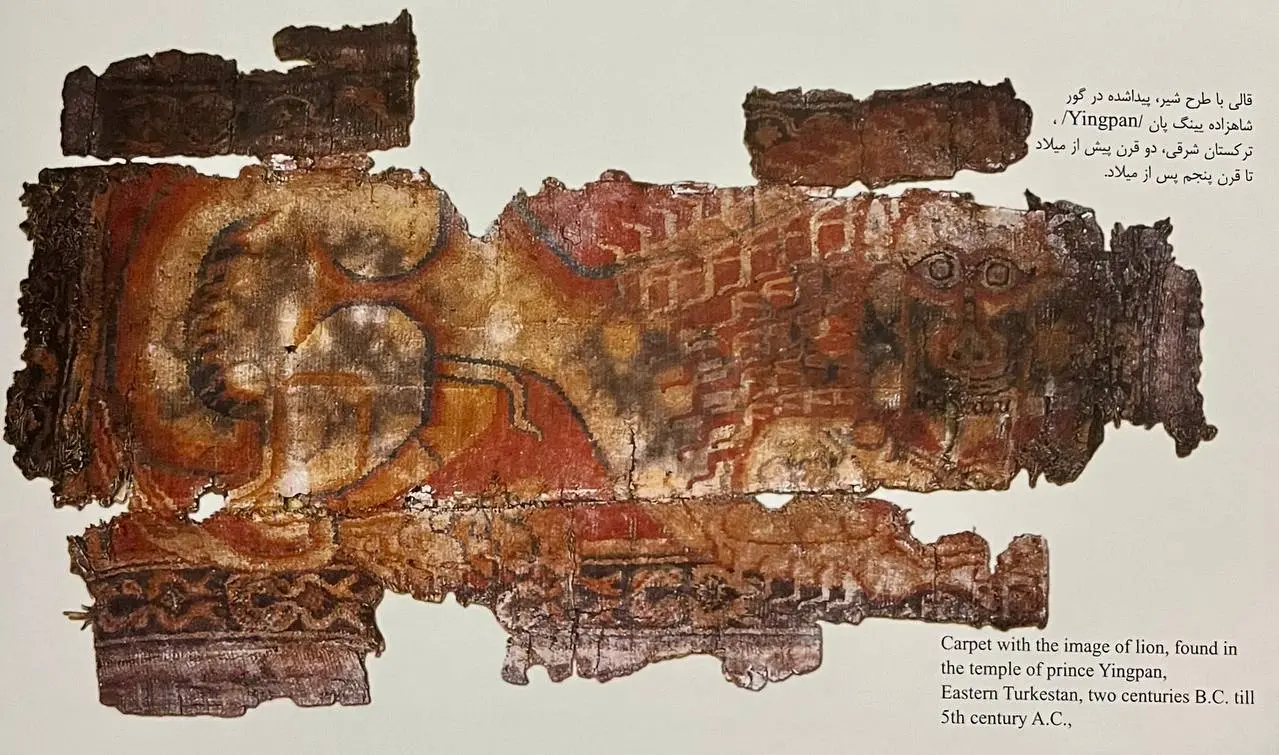
The very ruins are remains of buildings that should have been a significant commercial centre in Gushan. In winter 1995, vast excavations were done by groups of Institute of Archeology of Urumchi and more than hundred tombs were discovered. In this discovery a lot of objects such as wood, textile, ceramic, bronze and glass were found.
Tombs belong to Han-Jin era and were dug without any specific schedule.
There were simple holes with wooden coffin made by trunks. One of them, which were numbered 15, was distinct from the others due to its luxury appear-ance. This tomb was for a tall man, about 180 cm and around 30 years old. His body was embalmed and his clothes were still completely preserved and his face was completely covered by a mask. He was in a wooden coffin that was decorated by images of curved trees with flowers.
There was a pillow with the image of a rooster (frequent in cemeteries of Xin-jiang) under his head and a wooden mask on his face. There was a hand knotted textile of linen with some designs of gold on his body. His cloths were so elegant and just some parts of them were local productions and probably they had been made of goods provided from the Silk Road.
A woolen cover has been seen among his cloths that were adorned by hunting scenes and heroic images. So it was explicitly under influence of Greek style.
This precious cloth profited by western art and culture posed this hypothesis that the body belonged to a rich businessman form one of western countries. A country where was connected to Turkmenistan by the Silk Road.
A small carpet covered the coffin of prince. Based on a common tradition in China in Han era, luxury tombs had coffins that were adorned carefully or covered by silk wove items, a wooden coffin that was illustrated. Some objects were found during excavations that helped to complete and reconstruct the design of carpet. In length of carpet in the direction of warps, 312 cm were remained while in the direction of wefts 175 cm were preserved. The style of weaving was different from the carpet found in the tomb in Niya. The height was between 1.5 and 2 cm and knots just were on one warp and it was wound in form of U in this style. A woolen thread consisted of seven layers was passed after each row. There were 14 knots in each dm2 of length and 32 knois in each d2 of width of the carpet. There were four thousand knots in each m2. color spectrum used for this design was so rich: Red, yellow, green, Golden-rod, lemon yellow, green, blue-green, Aqua, blue, Barlic, pink, brown, gray and white.
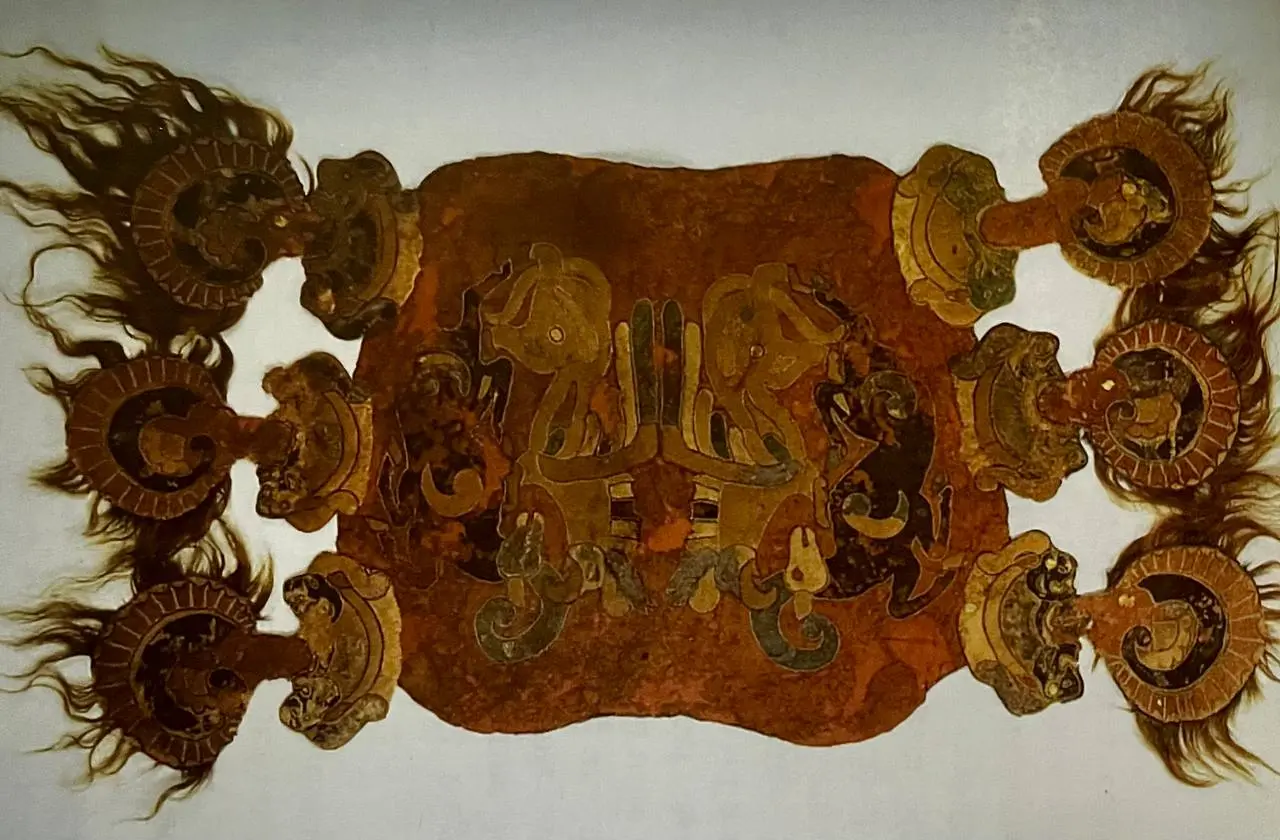
The first rug in the world is absolute to persian.
Good condition of pile indicates that the carpet shouldn’t have been used before and it was used just for burial. Used design in this carpet is interesting although it’s not visible completely due to ruining some parts of it. The background is light orange that ends to two frames; one frame is decorated by images of plants and the other one by geometrical images, but due to ruining, it’s not observable totally. Just a lion can be seen on the background. Carpets by this design are unique. The image of lion obviously occupies the background, and in some parts, the image of mane or claws went out of background and reached the border.
Lion is bent and drawn mutating: Narrow lumbar, elongated front legs and rear legs are bent, As induces its great power and facial images of faces with round black and wide open eyes and open mouth. A dense mane of wavy lines in orange and golden yellow surrounds his head.
In general, a traditional design had been used and indicated a brilliant technical capability. Evolution and standard designs are distinctive features of the knotted in Han era. In this era, used designs in wove items changed from geometrical designs into diamonds and winding and spiral ones. It’s conspicuous that in the end of Han epoch (25-220 AC), images of winged felines on stone and in art and traditions of burial had been employed that meant exorcism which was common. In that era texts, these feline were called Bixie that were creatures able to exorcise. They had long and flexible bodies and a rectanGülar head.
Exorcising and its conjunction with burial traditions can be an acceptable reason to use lion in found carpet on Yingpan prince’s body.
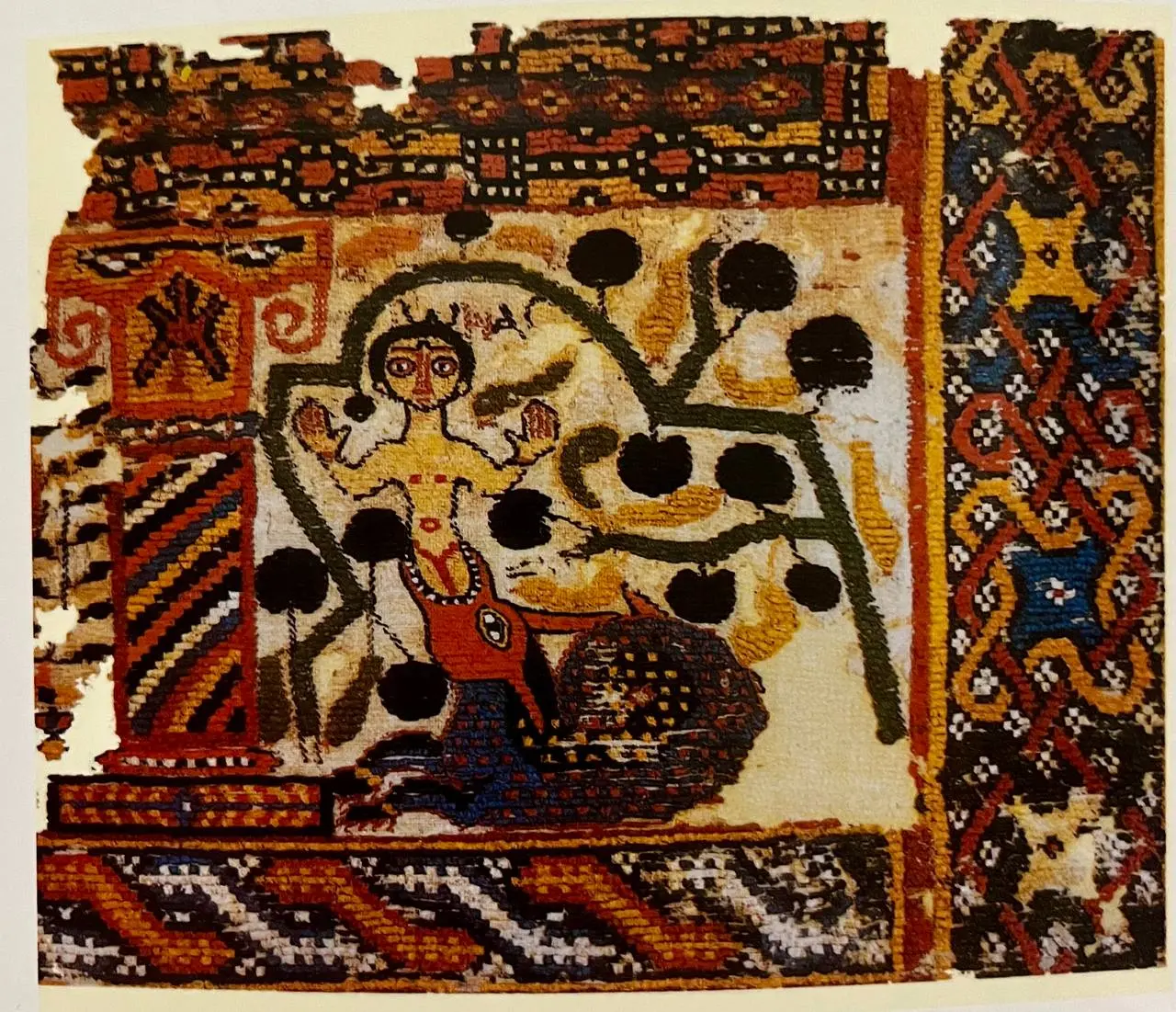
Many features of the carpet were similar to the products of East Asia, but full-face image of a wild animal in the art of the Han was not common because it was frequent to use cross-sectional and side profile image.
Instead, in the scene of battle of cow in Apadana, Per-spolis the embossed image carved on the limestone: a full-faced lion with closed eyes like a drop. There are clear lines that make the mouth and a terrifying scene of teeth are illustrated. Like what has been explained about Pazyryk carpet, study of the style of the design doesn’t remove the doubt about its origin and it’s impossible to certainly claim that it’s a local production, is originated from East Asia or belongs to Iran or middle east that had been reached Tarim area among exchanged goods in the Silk Road. However, it is notable that the lion is common in the decorative arts of Iran and India.
In ancient culture of Iran and India, lion is the symbol of power of kings and therefore it was a common decorative image in different artistic works both in architecture and home decorations. Neighborhood and close relations between the Xinjiang, Iran and India facilitated cultural and artistic exchanges between different civilizations in the region and the Silk Road (Yingpan had an important position in the direction) in these transactions was advantageous.
The origin of many of the findings of Yingpan Cemetery has been the area of West Mountain of Conglin, and it’s a fact that most residents were familiar with some objects such as glass that was obtained from Iran plateau and woolen textiles of Battriana.
So it can be said that Yingpan carpet has reached to Xinjiang through the Silk Road like these objects. Design of the carpet that was related to the burial traditions, obtained from vast desserts of Xinjiang, wonderfully resembles another ancient carpet that was discovered 60 years after that in Alfostat ruins near Cairo and was purchased by Fine Arts Museum of San Francisco in 1996.
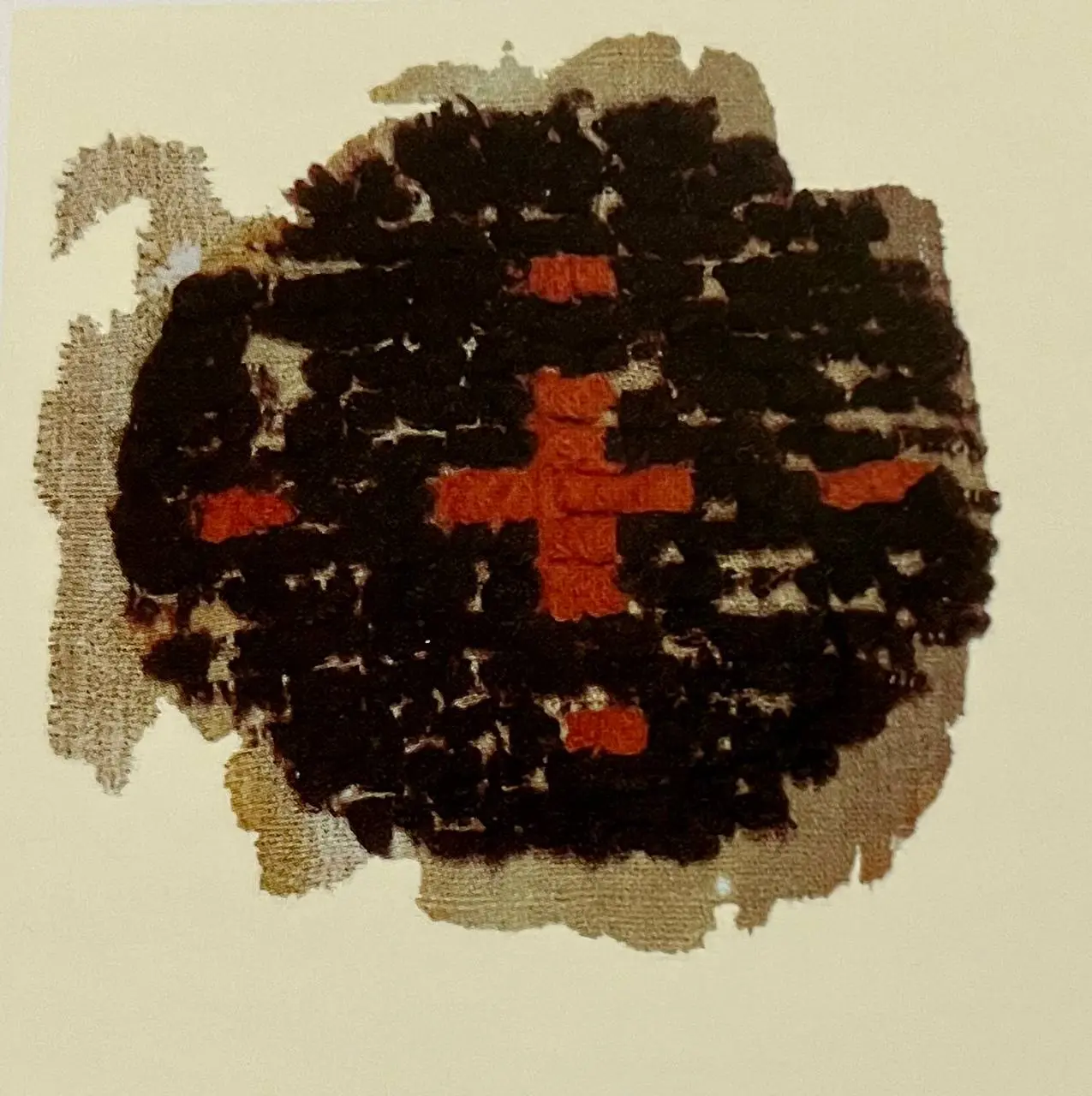
Old area of Alfostat that was a significant textile cen-tre form beginning of seventh century has been considered s a crucial information source about Egypt in medieval era: The unique dry sandy soil assisted the preservation of the wove items that could be destroyed very quickly in an amazing manner. In this area a lot of hand-wove items have been found especially at the bottom of many wells that a large number of wove carpets wove with different techniques with an almost complete carpet were obtained. Alfostat carpet dated back to the seventh century AD by Radiocarbon dating method. This carpet is small, too. And some parts have been destroyed; background had been illustrated in a frame. There was an image of winding vines and arrows. Long strips without decoration that were pile-free could be seen on both ends of the carpet. A simple image of lion is visible in the frame that although has been illustrated carefully with geometrical shapes, there are mutual features with the Yingpan carpet. The situation of the lion, long legs and observable claws, full-face and mane and also winding and colorful images are the mutual features of both carpets.
Top and bottom kilim-wove parts of the carpet that have been preserved well instigate the thought that the carpet had had very limited application and some guesses indicate that found sample in Alfostat had been used in burial, too.
Weaving features and especially thread with Z spinning caused that relate this carpet to the Middle East and Mediterranean area rather than Egypt.
Undoubtedly mutual features of both old carpets are crucial evidence and both of them are peerless find-ings, which had been probably used, in burial ceremonies by a symbolic design. We can consider Alfostat carpet a simple derivation of the other one. Anyway it’s not strange that both carpets deliver precious information about knotted carpets of before Islam epoch.
